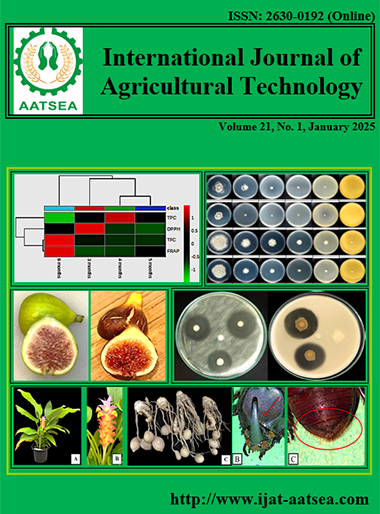Safe and Sustainable Propagation of Insulin Plant (Costus igneus) through a Recirculating Aquaponic System Using Nile Tilapia (Oreochromis niloticus) and Duckweed (Lemna perpusilla)
Main Article Content
Abstract
This study introduces an innovative approach to cultivate Costus igneus using aquaponic system, ensuring both sustainable cultivation and safe consumption of this valuable medicinal herb. The system with mollies maintained a pH level between 7.6-7.8, total dissolved solids (TDS) of 296-314 ppm, and temperatures between 28.7°C to 29.6°C. Results indicated that the presence of mollies in the aquaponic system led to slightly faster growth and improved yields of Nile tilapia, as well as higher duckweed yields. Water analysis revealed that the molly-containing system exhibited higher levels of essential nutrients such as nitrogen, potassium, and phosphorus, resulting in increased Insulin plant fresh weight. The molly fish's presence proved beneficial in breaking down fish waste and facilitating nutrient conversion, particularly nitrogen, for plant utilization.
Article Details

This work is licensed under a Creative Commons Attribution-NonCommercial-NoDerivatives 4.0 International License.
References
Anderson, M., Bloom, L., Queen, C., Rutternburg, M., Stroad, K., Sukanit, S., & Thomas, D. (1989). Understanding Hydroponics. VITA Publication. Arlington, Virginia 22209 USA
Devi, V.D. & Urooj, A. (2008). Hypoglycemic potential of Morus indica L. and Costus Igneus. Nak: A preliminary study. Indian Journal of Experimental Biology 46(8): 614-6
Hatfield, J.L 7 Prueger, J.H. (2015). Temperature extremes: Effect on plant growth and development. Journal of Weather and Climate Extremes 10:4-10. https://doi.org/10.1016/j.wace. 2015. 08. 001
Hedge, P. K., Rao, H.A. & Rao, P.N. (2014). A review on Insulin plant (Costus igneus). Pharmacognosy Review. 8(15): 67-72. https://doi.org/10.4103/0973-7847.125536
Kulhari, A., Sheorayan A., Bajar S., Sarkar, S. Chaudhury, A. & Kalia, R. K. (2013). Investigation of heavy metals in frequently utilized medicinal plants collected environmentally diverse locations of north western India. Springerplus, 2:676
Leaffin, (2017). What is the Optimum Range of Temperature for Aquaponics.Retrieved from https://www.leaffin.com/optimum-temperature-aquaponics/
Lennard, W. (2012). Aquaponic System Design Parameters: Media Beds and Sizing, Aquaponic Fact Sheet Series-Media Beds and Sizing. Aquaponic Fact Sheet Series Media Beds and Sizing. Retrieved from https://www.aquaponic.com au/Media%20beds%20and% 20design.pdf
Monnet, F., Vaillant, N., Hitmi, A., Vernay, P, & Coudret, A. (2002). Treatment of domestic wastewater using nutrient film technique (NFT) to produce horticultural roses Water Research 36:3489-3496
Pennigton, D. (2011). The History of Aquaponics. International Aquaponics and Tilapia Aquaculture Course: Retrieved from htt://www.uvi.edu/sites/uvi/Pages/AES- Aquaculture-International Aquaponics.aspx? s=Recited
Rakocy, J. (2007). Ten Guidelines for aquaponics system. Aquaponics Journal 3rd quarter2:14-17
Roe, B. & Midmore, D. J. (2008). Sustainable aquaponics. Center for Plant and Water Science. CQUniversity, Rockhampton, Queensland, Australia (Issue 103. Hydroponics and Greenhouses
Sace, C. F. & Fitzsimmons, K.M. (2014). Vegetable production in a recirculating aquaponic system using Nile tilapia (Oreochromis niloticus) with and without freshwater prawn (Macrobrachium rosenbergii). Academia Journal of Agricultural Research 1:236-250.
Shamshiri, R.R., Thorp, K., Jones, J.W. and Taheri, S. (2018). Review of optimum temperature, humidity and vapour pressure deficit for microclimate evaluation in greenhouse cultivation of tomato: A Review. International Agrophysiscs 32(2):287-302
Shetty, A., Choudhury, D., Nair, V., Kruvilla, M., and Kotian, S. (2010). Effect of the insulin plant (Costus igneus) leaves on dexamethasone-induced hyperglycemia. Int Journal of Ayurveda Research. 1(2): 100-102
Shu, A. (2014). Components of an Aquaponic System. Retrieved from http://www.projectfeed1010.com/blog/2014/07/15/aquaponics-components/
Tyson, R.V. (2007). Reconciling pH for Ammonia Biofiltration in a Cucumber/Tilapia in Aquaponic System Using a Perlite Medium. University of Florida USA HortScience 43(3):719-724


